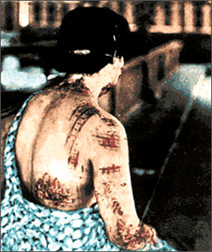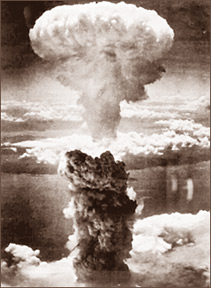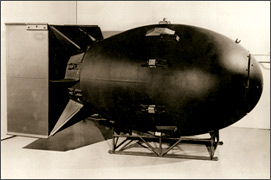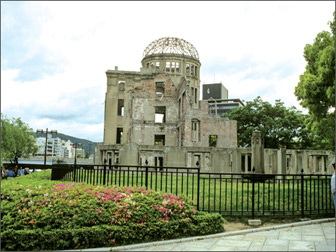|
64th Anniversary :
Hiroshima and Nagasaki bombs
|

The dark portion of the garments were emblazioned on to the
flesh as scars as the energy released by the bomb was powerful
enough to burn through clothing.
|
|

The Fat Man mushroom cloud resulting from the nuclear explosion
over Nagasaki rises 18 km (11 mi, 60,000 ft) into the air from
the hypocentre.
|
For the 34th consecutive year, people in Christchurch will hold a
lantern ceremony on the Avon River in remembrance of those who died and
the Hibakusha (survivors) of the atomic bombings of Hiroshima and
Nagasaki. Beforehand there will be a ringing of the World Peace Bell in
the Botanical Gardens, and a gathering at the WEA with speakers, music,
poetry and peace crane making.
A peal for peace
The World peace bell in the botanical gardens will ring out at the
exact moment of the anniversary of the bombing of Nagasaki. This is part
of an international effort, known as ‘A peal for peace project’, to mark
the anniversaries with bell ringing across the globe. The project aims
to connect with people around the world to transform the remembrance of
horror into a rededication of life. This will take place at 3:15pm, at
the World Peace Bell (across the river from the Band Rotunda).
Speakers, music, poetry and afternoon tea
A gathering is planned at the WEA (59 Gloucester St) between the bell
ringing and lantern ceremony. Speakers include Councillor Chrissie
Williams on local peace issues and Natasha Barnes, a Canterbury
University student who recently attended the Non-proliferation Treaty
negotiations in New York.
A variety of musicians will perform, including a Japanese choir, and
afternoon tea will be available. There will also be an opportunity to
learn how to make origami peace cranes, before we walk down to the river
to float the lanterns.
Lantern ceremony

The Fat Man: Fat Man is the codename for the atomic bomb
that was detonated over Nagasaki, Japan, by the United States on
August 9, 1945, at 11:02 a.m. (JSP). It was the second of the
only two nuclear weapons to be used in warfare and was the third
man-made nuclear explosion.

Little Boy: Little Boy was the codename of the atomic
bomb that was dropped on Hiroshima on August 6, 1945 by the B-29
Super fortress Enola Gay, piloted by Colonel Paul Tibbetsin the
393d Bombardment Squadron, Heavy of the United States Army Air
Forces. It was the first atomic bomb ever used as a weapon, and
was dropped three days before the “Fat Man” bomb was used
against Nagasaki.
|
It is 64 years since the nuclear bombs were dropped on the Japanese
cities of Hiroshima and Nagasaki. Each year the people of these cities
float lanterns out to sea in memory of those who perished. By floating
lanterns into a river that flows into the same ocean we affirm that we
will continue to work for the removal of all nuclear weapons from the
earth, and to secure a peaceful future for all.
Since 1975, Christchurch has commemorated Hiroshima and Nagasaki Days
with a lantern ceremony on the Avon River. It is an opportunity for the
city to share in the message ‘Hiroshima and Nagasaki - Never Again’. The
lantern floating ceremony is visually stunning, and offers an excellent
and unique photographic opportunity.
This event is organized by Women’s International League for Peace and
Freedom (Otautahi branch) and The Quakers Religious Society of Friends
with support from Christchurch City Council Peace City. For more
information, contact Mia 980 4884.
The history
The bombs killed as many as 140,000 people in Hiroshima and 80,000 in
Nagasaki by the end of 1945, roughly half on the days of the bombings.
Amongst these, 15-20 percent died from injuries or the combined effects
of flash burns, trauma, and radiation burns, compounded by illness,
malnutrition and radiation sickness. Since then, more have died from
leukemia (231 observed) and solid cancers (334 observed) attributed to
exposure to radiation released by the bombs. In both cities, the
majority of the dead were civilians.
The United States, in collaboration with the United Kingdom and
Canada, with their respective secret projects Tube Alloys and Chalk
River Laboratories, designed and built the first atomic bombs under what
was called the Manhattan Project. The scientific research was directed
by American physicist J. Robert Oppenheimer.
The Hiroshima bomb, a gun-type bomb called “Little Boy”, was made
with uranium-235, a rare isotope of uranium. The atomic bomb was first
tested at Trinity Site, on July 16, 1945, near Alamogordo, New Mexico.
The test weapon, “the gadget,” and the Nagasaki bomb, “Fat Man”, were
both implosion-type devices made primarily of plutonium-239, a synthetic
element.
Target
On May 10-11, 1945 The Target Committee at Los Alamos, led by J.
Robert Oppenheimer, recommended Kyoto, Hiroshima, Yokohama, and the
arsenal at Kokura as possible targets.
About an hour before the bombing, Japanese early warning radar
detected the approach of some American aircraft headed for the southern
part of Japan. An alert was given and radio broadcasting stopped in many
cities, among them Hiroshima.
At nearly 08:00, the radar operator in Hiroshima determined that the
number of planes coming in was very small-probably not more than
three-and the air raid alert was lifted. To conserve fuel and aircraft,
the Japanese had decided not to intercept small formations. The normal
radio broadcast warning was given to the people that it might be
advisable to go to air-raid shelters if B-29s were actually sighted, but
no raid was expected beyond some sort of reconnaissance.
The name also refers more generically to the early nuclear weapon
designs of U.S. weapons based on the “Fat Man” model.
The blast
|

A UNESCO World Heritage Site, this memorial is a reminder of
WW2. The atomic bomb exploded directly above this dome. Prior to
the bombing, this building was formerly Hiroshima Commercial
Museum. |
|

The mushroom cloud over Hiroshima after the dropping of Little
Boy |
It was an implosion-type weapon with a plutonium core, similar to the
Trinity device tested only a month earlier in New Mexico The release at
08:15 (Hiroshima time) went as planned, and the gravity bomb known as
“Little Boy”, a gun-type fission weapon with 60 kilograms (130 lb) of
uranium-235, took 57 seconds to fall from the aircraft to the
predetermined detonation height about 600 metres (2,000 ft) above the
city. Due to crosswind, it missed the aiming point, the Aioi Bridge, by
almost 800 feet (240 m) and detonated directly over Shima Surgical
Clinic.
It created a blast equivalent to about 13 kilotons of TNT. (The U-235
weapon was considered very inefficient, with only 1.38 percent of its
material fissioning.)
The radius of total destruction was about one mile (1.6 km), with
resulting fires across 4.4 square miles (11 km). Americans estimated
that 4.7 square miles (12 km2) of the city were destroyed.
Japanese officials determined that 69 percent of Hiroshima’s
buildings were destroyed and another 6-7 percent damaged. 70,000-80,000
people, or some 30 percent of the population of Hiroshima were killed
immediately, and another 70,000 injured.
Over 90 percent of the doctors and 93 percent of the nurses in
Hiroshima were killed or injured; most had been in the downtown area
which had been greatly damaged. The surviving victims of the bombings
are called hibakusha , a Japanese word that literally translates to
“explosion-affected people.”
The suffering caused by the bombing has led Japan to seek the
abolition of nuclear weapons from the world ever since, exhibiting one
of the world’s firmest non-nuclear policies. As of March 31, 2008,
243,692 hibakusha were recognized by the Japanese government, most
living in Japan.
The Government of Japan recognizes about 1 percent of these as having
illnesses caused by radiation.
The memorials in Hiroshima and Nagasaki contain lists of the names of
the hibakusha who are known to have died since the bombings. Updated
annually on the anniversaries of the bombings, as of August 2008 the
memorials record the names of more than 400,000 hibakusha,258,310 in
Hiroshima and 145,984 in Nagasaki.
Source: Women’s International League for Peace and Freedom and
Wikipedia
|



